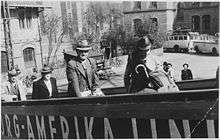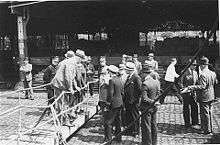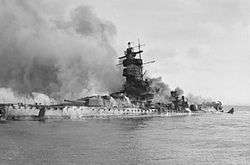MS St. Louis
 | |
| History | |
|---|---|
| Name: | St. Louis |
| Owner: | Hamburg-America Line |
| Port of registry: |
|
| Builder: | Bremer-Vulkan Shipyards in Bremen, Germany |
| Laid down: | June 16, 1925 |
| Launched: | August 2, 1928 |
| Maiden voyage: | March 28, 1929 |
| Fate: | Scrapped in Bremerhaven, Germany, 1952 |
| General characteristics | |
| Type: | Cruiser |
| Tonnage: | 16,732 gross register tons (GRT) |
| Length: | 574 ft (175 m) |
| Beam: | 72 ft (22 m) |
| Propulsion: | M.A.N. diesels, twin triple-blade propellers |
| Speed: | 16 knots (30 km/h/18 mph) |
| Capacity: | 937 passengers (270 cabin, 287 tourist, 416 third) |
MS St. Louis was a German ocean liner. In 1939, she set off on a voyage in which her captain, Gustav Schröder, tried to find homes for over 900 Jewish refugees from Germany. Due to countries' immigration policies based on domestic political realities, rather than humanitarian grounds, they were denied entry to Cuba, the United States, and Canada. The refugees were finally accepted in various European countries, including Belgium, the Netherlands, the UK, and France. Historians have estimated that approximately a quarter of them died in death camps during World War II.[2] The event was the subject of a 1974 book, Voyage of the Damned, by Gordon Thomas and Max Morgan-Witts. It was adapted for a 1976 U.S. film of the same title, a 1994 opera titled St. Louis Blues by Chiel Meijering, and adapted in one third of the 2016 Alan Gratz novel for young adults, titled Refugee.
Background
Built by the Bremer Vulkan shipyards in Bremen for HAPAG, better known in English as the Hamburg America Line, St. Louis was a diesel-powered ship (as opposed to a diesel-fired steamer) and properly referred to with the prefix MS or MV, but she is often known as SS St. Louis. The ship was named after the city of St. Louis, Missouri. (Her sistership, the MS Milwaukee, was also a diesel motor ship/motor vessel owned by the Hamburg America Line). St. Louis regularly sailed the trans-Atlantic route from Hamburg to Halifax, Nova Scotia and New York and made cruises to the Canary Islands, Madeira and Morocco. St. Louis was built for both transatlantic liner service and for leisure cruises.
"Voyage of the Damned"
St. Louis set sail from Hamburg to Cuba on May 13, 1939. The vessel under command of Captain Gustav Schröder was carrying 937 passengers, most of them Jewish refugees[3][4] seeking asylum from Nazi ill-treatment of Jews in Germany (→ Kristallnacht, Racial policy of Nazi Germany). Captain Schröder was a non-Jewish German[5] who went to great lengths to ensure dignified treatment for his passengers.
The passengers aboard St. Louis had suffered abuse in Germany, but on board, they were treated very well, at the insistence of Captain Schröder.[6] Food served included items subject to rationing in Germany, and childcare was available while parents dined. Dances and concerts were put on, and on Friday evenings, religious services were held in the dining room. A bust of Hitler was covered by a tablecloth. Swimming lessons took place in the on-deck pool. Lothar Molton, a boy traveling with his parents, said that the passengers thought of it as "a vacation cruise to freedom".[7]
The ship dropped anchor at 04:00 on May 27 at the far end of the Havana Harbor but was denied entry to the usual docking areas. The Cuban government, headed by President Federico Laredo Brú, refused to accept the foreign refugees. Although passengers had previously purchased legal visas, they could not enter Cuba either as tourists (laws related to tourist visas had recently been changed) or as refugees seeking political asylum. On May 5, 1939, four months before World War II began, Havana abandoned its former pragmatic immigration policy and instead issued Decree 937, which "restricted entry of all foreigners except U.S. citizens requiring a bond of $500 and authorization by the Cuban secretaries of state and labor. Permits and visas issued before May 5 were invalidated retroactively.[8] None of the passengers were aware that the Cuban government had retroactively invalidated their landing permits.
After 5 days in the harbor, only 29 passengers were allowed to disembark in Cuba.[9][10] Twenty-two of them were Jews that had valid US visas; of the others, four were Spanish citizens and two were Cuban nationals, all with valid entry documents. The last was a medical evacuee who, after attempting to commit suicide, was taken to a hospital in Havana.[3]

Telephone records show American officials Cordell Hull, Secretary of State, and Henry Morgenthau, Secretary of the Treasury had made some efforts to persuade Cuba to accept the refugees. Their actions, together with efforts of the American Jewish Joint Distribution Committee, were not successful.[10]
Prohibited from landing in Cuba, St. Louis and the remaining 907 refugees[11] headed towards the United States. Captain Schröder circled off the coast of Florida, hoping for permission to enter the United States. Cordell Hull, Secretary of State, advised Roosevelt not to accept the Jews, however. Captain Schröder considered running aground along the coast to allow the refugees to escape, but, acting on Cordell Hull's instructions, US Coast Guard vessels shadowed the ship and prevented such a move.
After St. Louis was turned away from the United States,[12] a group of academics and clergy in Canada tried to persuade Canada's Prime Minister, William Lyon Mackenzie King, to provide sanctuary to the ship's passengers, as it was only two days from Halifax, Nova Scotia.[13] But Canadian immigration official Frederick Blair, hostile to Jewish immigration, persuaded the prime minister on June 9 not to intervene. In 2000, Blair's nephew apologized to the Jewish people for his uncle's action.[14]
The situation of the vessel deteriorated as Captain Schröder negotiated and schemed to find them a safe haven. At one point he formulated plans to wreck the ship on the British coast to force the passengers to be taken as refugees. He refused to return the ship to Germany until all the passengers had been given entry to some other country. US officials worked with Britain and European nations to find refuge for the travelers in Europe.[10] The ship returned to Europe, docking at the Port of Antwerp (Belgium) on June 17, 1939, with 907 passengers.[15][16]
The United Kingdom (PM: Neville Chamberlain) agreed to take 288 (32%) of the passengers, who disembarked and traveled to the UK via other steamers. After much negotiation by Schröder, the remaining 619 passengers were allowed to disembark at Antwerp; 224 (25%) were accepted by France, 214 (23.59%) by Belgium, and 181 (20%) by the Netherlands. Without any passengers, the ship returned to Hamburg. The following year, after the Nazi German invasions of Belgium, France and the Netherlands in May 1940, all the Jews in those countries were at renewed risk, including the recent refugees.[17][18]

By using the survival rates for Jews in various countries, Thomas and Morgan-Witts, the authors of Voyage of the Damned, estimated that 180 of St. Louis refugees in France, 152 of those in Belgium, and 60 of those in the Netherlands survived the Holocaust. Including the passengers who landed in England, of the original 936 refugees (one man died during the voyage), roughly 709 survived the war and 227 did not.[19][10]
Later research by Scott Miller and Sarah Ogilvie of the United States Holocaust Memorial Museum did an actual historical trace on the fate of each passenger.[20] They determined that 254 of those who returned to continental Europe were murdered during the Holocaust:
Of the 620 St. Louis passengers who returned to continental Europe, we determined that eighty-seven were able to emigrate before Germany invaded western Europe on May 10, 1940. Two hundred fifty-four passengers in Belgium, France, and the Netherlands after that date died during the Holocaust. Most of these people were murdered in the killing centers of Auschwitz and Sobibór; the rest died in internment camps, in hiding or attempting to evade the Nazis. Three hundred sixty-five of the 620 passengers who returned to continental Europe survived the war. Of the 288 passengers sent to Britain, the vast majority were alive at war's end.[21]
Legacy
After the war, Captain Gustav Schröder was awarded the Order of Merit by the Federal Republic of Germany. In 1993, Schröder was posthumously named as one of the Righteous among the Nations at the Yad Vashem Holocaust Memorial in Israel.[5] A display at the United States Holocaust Memorial Museum tells the story of the voyage of the MS St. Louis. The Hamburg Museum features a display and a video about St. Louis in its exhibits about the history of shipping in the city. In 2009, a special exhibit at the Maritime Museum of the Atlantic in Halifax, Nova Scotia entitled "Ship of Fate" explored the Canadian connection to the tragic voyage. The display is now a traveling exhibit in Canada.[22]
In 2011 a memorial monument called the Wheel of Conscience, was produced by the Canadian Jewish Congress, designed by Daniel Libeskind with graphic design by David Berman and Trevor Johnston.[23] The memorial is a polished stainless steel wheel. Symbolizing the policies that turned away more than 900 Jewish refugees, the wheel incorporates four inter-meshing gears each showing a word to represent factors of exclusion: antisemitism, xenophobia, racism, and hatred. The back of the memorial is inscribed with the passenger list.[24] It was first exhibited in 2011 at the Canadian Museum of Immigration at Pier 21, Canada's national immigration museum in Halifax. After a display period, the sculpture was shipped to its fabricators, Soheil Mosun Limited, in Toronto for repair and refurbishment.[25]
In 2012, the United States Department of State publicly apologized in a ceremony attended by Deputy Secretary Bill Burns and 14 survivors of the incident.[26] The survivors presented a proclamation of gratitude to various European countries for accepting some of the ship’s passengers. A signed copy of Senate Resolution 111, recognizing June 6, 2009 as the 70th anniversary of the incident, was delivered to the Department of State Archives.[26]
In January 2017, software engineer Russel Neiss and Rabbi Charlie Schwartz set up a Twitter account which tweeted the names of each passenger who was not allowed to disembark and subsequently killed. The format of each tweet included the passenger's name, the sentence "The US turned me away at the border in 1939" and the location where each was killed.[27]
In May 2018, Prime Minister Justin Trudeau announced the Government of Canada would offer a formal apology in the country's House of Commons for its role in the fate of the ship's passengers.[28]
Later career
The MS St. Louis was adapted as a German naval accommodation ship from 1940 to 1944. She was heavily damaged by the Allied bombings at Kiel on August 30, 1944, but was repaired and used as a hotel ship in Hamburg in 1946. She was later sold and was scrapped in 1952.
Notable passengers
- Leon Joel, great-uncle of American singer-songwriter Billy Joel[29]
- Arno Motulsky (1923-2018), genome scientist[30]
Representation in other media
- 1976 film Voyage of the Damned by Stuart Rosenberg
- Julian Barnes's 1989 novel A History of the World in 10½ Chapters recounts the trial of the MS St. Louis Jews in the chapter "Three Simple Stories"
- Bodie and Brock Thoene's 1991 novel Munich Signature
- Irving Abella and Harold Troper's None Is Too Many: Canada and the Jews of Europe 1933-1948, a non-fiction history of Canada's restrictions on Jewish immigration in the 1930s and 1940s
- Leonardo Padura's novel Herejes (Tusquets, 2013) centers around the St. Louis incident.
- Jan de Hartog's play "Schipper naast God", 1942, translated "Skipper next to God", 1945.
- Nilo Cruz' 2014 play "Sotto Voce", a work of historical fiction dealing with modern remnants of the ship's tragedy.
- 2016 novel The German Girl by Armando Lucas Correa
- 2017 young adult novel Refugee by Alan Gratz
See also
- SS Patria, sunk by a Haganah bomb on 25 November 1940 in the Port of Haifa.
- SS Navemar, designed for 28 passengers, in 1941 the vessel carried 1,120 Jewish refugees to New York.
- MV Struma, a schooner chartered to carry Jewish refugees that was torpedoed and sunk by a Soviet submarine on 5 February 1942.
- MV Mefküre, a schooner carrying Jewish refugees that was torpedoed and sunk by a Soviet submarine on 5 August 1944.
- Komagata Maru, a merchant ship carrying Asian migrants that was denied entry to Canada in 1914.
Notes
- ↑ Photo Archives United States Holocaust Memorial Museum
- ↑ Madokoro, Laura. "Remembering the Voyage of the St. Louis". Active History.
- 1 2 "United States Holocaust Memorial Museum completes ten-year search to uncover the fates of St. Louis passengers" (Press release). United States Holocaust Memorial Museum. October 6, 2006. Archived from the original on June 26, 2007. Retrieved July 17, 2007.
- ↑ Rosen, p. 563.
- 1 2 "The Righteous Among The Nations: Gustav Schroeder". Yad Vashem. Retrieved Jan 29, 2017.
- ↑ Levine, p. 105.
- ↑ Levine, pp. 110–11.
- ↑ Levine, p. 103
- ↑ Levine, p. 114.
- 1 2 3 4 Rosen, Robert (July 17, 2006). Saving the Jews (Speech). Carter Center (Atlanta, Georgia). Retrieved July 17, 2007.
- ↑ "The Voyage of the St. Louis" (PDF). American Jewish Joint Distribution Committee. June 15, 1939. Retrieved Jan 29, 2017.
- ↑ "What was the Coast Guard's role in the SS St. Louis affair, often referred to as "The Voyage of the Damned"?". United States Coast Guard History. Dec 21, 2016. Retrieved Jan 29, 2017.
- ↑ "Maritime Museum Exhibit on Tragic Voyage of MS St. Louis", November 5, 2010, Nova Scotia Government Press Release; accessed September 12, 2014.
- ↑ "Clergy apologize for turning away the St. Louis", CBC website; retrieved 2008-05-08.
- ↑ George Axelsson, "907 Refugees End Voyage in Antwerp", New York Times, June 18, 1939
- ↑ Levine, p. 118.
- ↑ Rosen, pp. 103, 567.
- ↑ "The Tragedy of the S.S. St. Louis". Retrieved July 17, 2007.
- ↑ Rosen, pp. 447, 567 citing Morgan-Witts and Thomas (1994) pp. 8, 238
- ↑ Refuge Denied: The St. Louis Passengers and the Holocaust, Scott Miller and Sarah Ogilvie, University of Wisconsin Press, 2010
- ↑ Miller and Ogilvie, pp. 174–75
- ↑ "Traveling Exhibit MS St. Louis Ship of Fate", Maritime Museum of the Atlantic
- ↑ Studio Daniel Libeskind, daniel-libeskind.com, 19 January 2011; retrieved 21 January 2011.
- ↑ Taplin, Jennifer (21 January 2011). "Perpetual Memorial of Regret". Metro News Halifax. Archived from the original on 10 March 2016. Retrieved 22 March 2017.
- ↑ "Exhibitions", Canadian Museum of Immigration at Pier 21, pier21.ca; accessed 12 September 2014.
- 1 2 Eppinger, Kamerel. "State Department apologizes to Jewish refugees". shfwire.com. Retrieved 26 September 2017.
- ↑ Daley, Jason. "Haunting Twitter Account Shares the Fates of the Refugees of the St. Louis". smithsonianmag.com. Retrieved 26 September 2017.
- ↑ "Trudeau to offer formal apology in Commons for fate of Jewish refugee ship MS St. Louis". Retrieved 11 May 2018.
- ↑ "Billy Joel über die Enteignung seiner jüdischen Familie, Bühnentriumphe und gescheiterte Ehen". stern.de. Retrieved June 5, 2018.
- ↑ Holding out hope in a cruel world publ.: University of Washington
References
- Levine, Robert M. (1993). Tropical Diaspora: The Jewish Experience in Cuba. Gainesville: University Press of Florida. p. 103. ISBN 9781558765214.
- Miller, Scott; Sarah A. Ogilvie (2006). Refuge Denied: The St. Louis Passengers and the Holocaust. Madison: University of Wisconsin Press. ISBN 978-0-299-21980-2. OCLC 64592065.
- Rosen, Robert (2006). Saving the Jews: Franklin D. Roosevelt and the Holocaust. New York: Thunder's Mouth Press. ISBN 978-1-56025-778-3. OCLC 64664326.
- Whitaker, Reginald (1991). Canadian Immigration Policy. Ottawa: Canadian Historical Association. ISBN 0-88798-120-8.
Further reading
- Levinson, Jay. Jewish Community of Cuba: Golden Years, 1906–1958, Nashville, TN: Westview Publishing, 2005. (See Chapter 10)
- Morgan-Witts, Max; Gordon Thomas (1994). Voyage of the Damned (2nd, revised (first in 1974) ed.). Stillwater, Minnesota: Motorbooks International. ISBN 978-0-87938-909-3. OCLC 31373409.
- Ogilvie, Sarah; Scott Miller. Refuge Denied: The St. Louis Passengers and the Holocaust, Madison, WI: University of Wisconsin Press, 2006.
- Sampson, Pamela. No Reply: A Jewish Child Aboard the MS St. Louis and the Ordeal That Followed, Atlanta, GA, 2017
- Lawlor, A. The Saddest Ship Afloat: The Tragedy of the MS St. Louis, Nimbus Publishing, 2016. ISBN 978-1771083997
External links
| Wikimedia Commons has media related to SS St. Louis. |
| Library resources about MS St. Louis |
- Robert Rosen, "Carter Center Library Speech" on "The S.S. St. Louis", July 17, 2006, Saving the Jews: Franklin D. Roosevelt and the Holocaust
- "The St. Louis", US Coast Guard's official FAQ
- "American Responses to the Holocaust - St. Louis", U.S. Holocaust Memorial Museum
- "The Story of the S.S. St. Louis (1939)" American Jewish Joint Distribution Committee Archives
- "SS St Louis: The ship of Jewish refugees nobody wanted" BBC News
